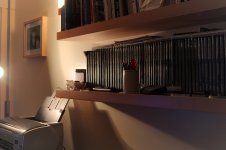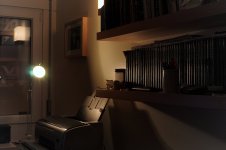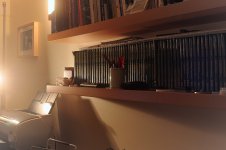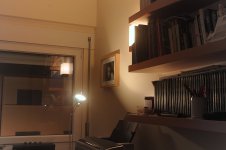ambientmick said:
Thanks for the reply. I mostly shoot street. Getting both is not an option because having 2 lenses of the same focal length means carrying more 'stuff'. I'd rather have a good allrounder rather than have to change lenses often. The 40/1.4 I already have, a 28 and possibly something wider (15mm maybe) are probably all I'll ever want. The 35/1.7 seems a lttle pointless given I have the 40/1.4.
You say that the 1.9 'significantly intrudes in the viewfinder' but does it cover any of the 28mm viewfinder area and if it doesn't intrude with the hood off, how prone is this lens to flare?
Hi,
I have the RD-1s, had both lenses and still keep the Ultron. Without the hood, it does not block the 28 framelines. WIth the hood, it blocks a bit vertically (maybe 1/6th to 1/5th of the framelines) and more horizontally (around 1/4th to 1/3rd), when focused on the 0.7m mark. When focused on infinity, it blocks a lot less, still a bit horizontally.
The Skopar is _much_ lighter and smaller. It's sharp enough but it vignettes a lot on the Epson. And it's much slower than the Ultron. Mechanicaly speaking, the Ultron is also more robust and build quality is better generally speaking. Moreover, the rendering I get from the Ultron is very unique: lots of detail but low contrast and I like that kind of image for B&W: it's easy to bump up contrast in Photoshop and it gives beutiful tones. I was expecting the 28 Skopar to perform as the 35 Skopar PII (which I own), but at least my sample didn't. So, the Skopar went.
Regarding flare, the Ultron does not show ghosts either with spot sources in the image or just outside the frame. Flare appears a global "haze", lowering the contrast, more than anything else. It behaves like my old Leica lenses in that respect.
This is different from my two other CV lenses and even the Zeiss Biogon: they tend to keep contrast even with flare but show some "ghost" image around the spot light (see pictures I took for this post, all at f/8. I can post the images wide-open but they are more or less the same regarding flare, or even better). I'm posting only pictures of the 35/2.5 Skopar, the worse of the three "new lenses" I own in this regard (but not very different from the Biogon 21/2.8 or the Nokton 50/1.5...).
I always keep the hood on, not because I see a big difference regarding flare (again, see images, the difference is small) but because it protects the lens from bumps. I could use a filter instead but filters tend to be much worse regarding flare.
Please notice that these are "torture" tests that most lenses would not be confortable with. And that they were all done in aperture priority: light conditions are not exactly the same so exposure is different. But you can see the points (I hope!).
If you don't really need a f/2 lens, the new Leica 28/2.8 Elmarit (or the Zeiss 28/2.8 Biogon) is probably worth the difference, if you can spend it: more contrast and saturation, not to mention the size: it's much smaller and light. BTW, I don't have a problem with weight but the Ultron is longer than most 28s, which makes it a bad lens to carry in a small bag/briefcase.
Otherwise, the Ultron is a very good lens in absolute terms and a steal regarding price: the 28/2 Summicron ASPH is much more expensive.
As I have the Zeiss 21/2.8 Biogon almost always on the Epson, and switch to the Skopar 35/2.5 or the Nokton 50/1.5 for tighter crops, the Ultron is really useful (for me) in two situations:
1) When using flash and trying to cover the largest possible field (the 21/2.8 or the 12/5.6 require an external viewfinder on the hotshoe). In those occasions, I tipically use the lens between f/5.6 and f/8 and you can cut yourself on the sharpness of those high-constrat 200 ASA shots...
😛
2) When I'll be shooting B&W for sure. The Ultron has a wonderful rendition in B&W on the Epson. It requires a bit of contrast "bump" when used wide-open but tonality and detail are lovely. The Ultron is my "most-used" lens for B&W.
The Ultron is perfectly capable of very good images, even wide-open, if you enjoy the lower contrast it gives you. It even can be "Photoshoped" to look similar very easily to other lenses, with a small bump of local contrast. And it matches very well the 28 framelines of the RD-1s.
I only find it lacking in low-light, low-contrast situation, where the "flat" rendering can become too flat.






